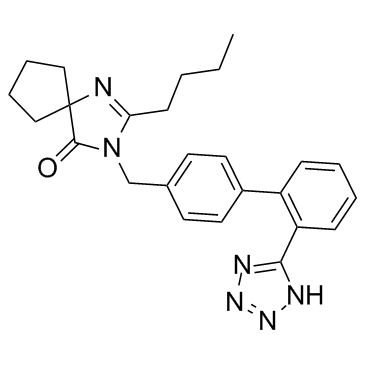Irbesartan

Irbesartan structure
|
Common Name | Irbesartan | ||
|---|---|---|---|---|
| CAS Number | 138402-11-6 | Molecular Weight | 428.529 | |
| Density | 1.3±0.1 g/cm3 | Boiling Point | 648.6±65.0 °C at 760 mmHg | |
| Molecular Formula | C25H28N6O | Melting Point | 180-181°C | |
| MSDS | Chinese USA | Flash Point | 346.0±34.3 °C | |
|
[Irbesartan in clinical practice].
Kardiologiia 52(11) , 66-74, (2012) Irbesartan is a noncompetitive angiotensin II receptor type 1 antagonist which has been successfully used for more than 10 years for the treatment of hypertensive disease. In a dose of 150-300 mg/day irbesartan produces long term effect for 24 hours. Its anti... |
|
|
Systemic sclerosis immunoglobulin induces growth and a pro-fibrotic state in vascular smooth muscle cells through the epidermal growth factor receptor.
PLoS ONE 9(6) , e100035, (2014) It has been suggested that autoantibodies in systemic sclerosis (SSc) may induce the differentiation of cultured fibroblasts into myofibroblasts through platelet-derived growth factor receptor (PDGFR) activation. The present study aims to characterize the eff... |
|
|
Optimum AT1 receptor-neprilysin inhibition has superior cardioprotective effects compared with AT1 receptor blockade alone in hypertensive rats.
Kidney Int. 88 , 109-20, (2015) Neprilysin inhibitors prevent the breakdown of bradykinin and natriuretic peptides, promoting vasodilation and natriuresis. However, they also increase angiotensin II and endothelin-1. Here we studied the effects of a low and a high dose of the neprilysin inh... |
|
|
Effects of Angiotensin II Receptor Blockers on Metabolism of Arachidonic Acid via CYP2C8.
Biol. Pharm. Bull. 38 , 1975-9, (2015) Arachidonic acid (AA) is metabolized to epoxyeicosatrienoic acids (EETs) via cytochrome enzymes such as CYP 2C9, 2C8 and 2J2. EETs play a role in cardioprotection and regulation of blood pressure. Recently, adverse reactions such as sudden heart attack and fa... |
|
|
Lack of efficacy of mTOR inhibitors and ACE pathway inhibitors as antifibrotic agents in evolving and established fibrosis in Mdr2⁻/⁻ mice.
Liver Int. 35(4) , 1451-63, (2015) Mammalian target of rapamycin and angiotensin-converting enzyme inhibition has been shown to have antifibrotic activity in models of liver fibrosis. The aim of our study was to determine the efficacy of rapamycin, everolimus, irbesartan and captopril, alone a... |
|
|
The impact of different proportions of a treated effluent on the biotransformation of selected micro-contaminants in river water microcosms.
Int. J. Environ. Res. Public Health 11(10) , 10390-405, (2014) Attenuation of micro-contaminants is a very complex field in environmental science and evidence suggests that biodegradation rates of micro-contaminants in the aqueous environment depend on the water matrix. The focus of the study presented here is the system... |
|
|
LC-MS screening techniques for wastewater analysis and analytical data handling strategies: Sartans and their transformation products as an example.
Chemosphere 137 , 198-206, (2015) A large number of anthropogenic trace contaminants such as pharmaceuticals, their human metabolites and further transformation products (TPs) enter wastewater treatment plants on a daily basis. A mixture of known, expected, and unknown molecules are discharge... |
|
|
The angiotensin-converting enzyme 2/angiotensin (1-7)/Mas axis protects against lung fibroblast migration and lung fibrosis by inhibiting the NOX4-derived ROS-mediated RhoA/Rho kinase pathway.
Antioxid. Redox Signal. 22(3) , 241-58, (2015) Reactive oxygen species (ROS) generated by NADPH oxidase-4 (NOX4) have been shown to initiate lung fibrosis. The migration of lung fibroblasts to the injured area is a crucial early step in lung fibrosis. The angiotensin-converting enzyme 2 (ACE2)/angiotensin... |
|
|
Searching the cytochrome p450 enzymes for the metabolism of meranzin hydrate: a prospective antidepressant originating from Chaihu-Shugan-San.
PLoS ONE 9(11) , e113819, (2014) Meranzin hydrate (MH), an absorbed bioactive compound from the Traditional Chinese Medicine (TCM) Chaihu-Shugan-San (CSS), was first isolated in our laboratory and was found to possess anti-depression activity. However, the role of cytochrome P450s (CYPs) in ... |
|
|
Lysophosphatidic acid enhances survival of human CD34(+) cells in ischemic conditions.
Sci. Rep. 5 , 16406, (2015) Several clinical trials are exploring therapeutic effect of human CD34(+) cells in ischemic diseases, including myocardial infarction. Unfortunately, most of the cells die few days after delivery. Herein we show that lysophosphatidic acid (LPA)-treated human ... |